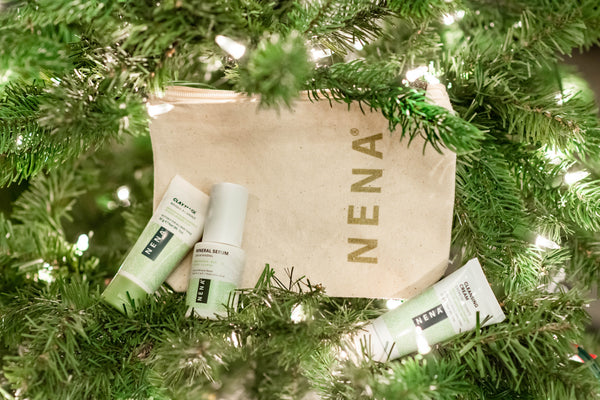7 Common Ingredients to Avoid in Your Skincare Products

Did you know that the skincare products you put on your skin is also absorbed by your skin? That means ingredients applied topically go further than skin deep, potentially seeping into your bloodstream and body. At NENA Skincare, we encourage our consumers to ask questions and educate themselves on ingredients used in the skincare industry; especially being aware of potentially harmful ingredients to avoid on the labels of skincare or beauty products.
For a shortcut to products that are safe from ingredients of concern, look for the EWG verified symbol on your beauty and skincare purchases, like we have on our NENA Skincare packaging.
-
Related Post: What Does EWG Verified Mean in Skincare Products?
To help our consumers understand common ingredients found in conventional skincare, bodycare, and beauty products, we’ve compiled a list of seven common ingredients we recommend avoiding. Note that none of these ingredients appear in NENA Skincare products.
Fragrance or Parfum
When you see the term fragrance or parfum listed on a cosmetic or skincare label, what that translates to is a complex mixture of dozens of chemicals. Manufacturers aren’t required to reveal the details of their “fragrance”, meaning consumers aren’t being shown the actual ingredients used in the final beauty or skincare product. These chemical blends are not tested for toxicity and are also known to be linked to allergies, migraines, and asthma-like symptoms.
At NENA Skincare, we scent our products with natural essential oils like lavender and bergamot.
Sodium Laureth Sulfate (also known as SLES)
This ingredient is what makes your cleanser foam and your shampoo bubble. In some studies, sodium laureth sulfate has been composed of a known human carcinogen, ethylene oxide and has been linked to irritating the skin and eyes. While there isn’t a lot of research on SLES, it has been recently noted by Health Canada as a “moderate human health priority” and has been flagged to undergo further assessment.
BHA & BHTs
BHA (butylated hydroxyanisole) is a synthetic antioxidant that can be found in an abundance of cosmetics and skincare products. Particularly, facial exfoliants. The usage of BHA is currently unrestricted within Canada but has been classified as a possible human carcinogen and has been noted to be linked to skin-based allergic reactions. Not something you want to see in your moisturizer or cleanser.
Oxybenzone
A chemical that is found in face products but is actually quite hard on your skin is oxybenzone. Most commonly found in sunscreen, it has been seen to be associated with many health issues, including endometriosis in women. So the next time you stock up on SPF, check the ingredient list. Pro tip: opt for a sunscreen that is mineral based. These types of sunscreens are more likely to be oxybenzone-free.
Triclosan
Commonly found in lotions, deodorants, cosmetics, and other skin cleansers, triclosan doesn’t pose a serious risk to users. However, it is deemed by the Government of Canada to be harmful to the environment, particularly living organisms in the water. If you are looking to make eco-friendly choices as a consumer, avoid products that have triclosan as an ingredient.
Petrolatum
Commonly found within a variety of moisturizers and hair care products, petrolatum is a mineral oil gel-like substance used to lock in moisture. There have been studies that show traces of polycyclic aromatic hydrocarbons (PAHs) within petrolatum and when these PAHs come into repeated contact with skin, it can be linked to cancer. Like BHA & BHTs, the usage of petrolatum isn’t restricted within Canada but has been flagged by the government for future assessment.
Siloxanes
Siloxanes are silicone-based and are often found in moisturizers, hair products and other various facial treatments. The purpose of this ingredient is to soften and smooth. While there are many types of siloxanes, D4 and D5 siloxanes are notably more harmful than others. Exposure to high doses of D5 have been linked to uterine tumours and harm to one’s reproductive and immune system. It was this and many other studies that led Environment Canada and Health Canada to regulate the use of such siloxanes within the cosmetic and skincare products in 2009.
With more skincare brands than ever, it can be overwhelming for shoppers to know what’s best for you, your skin, and the environment. You may not be able to always avoid all the ingredients in this list, but understanding the benefits and effects of these chemicals will help you better assess risk as a consumer and make smart and informed decisions.







